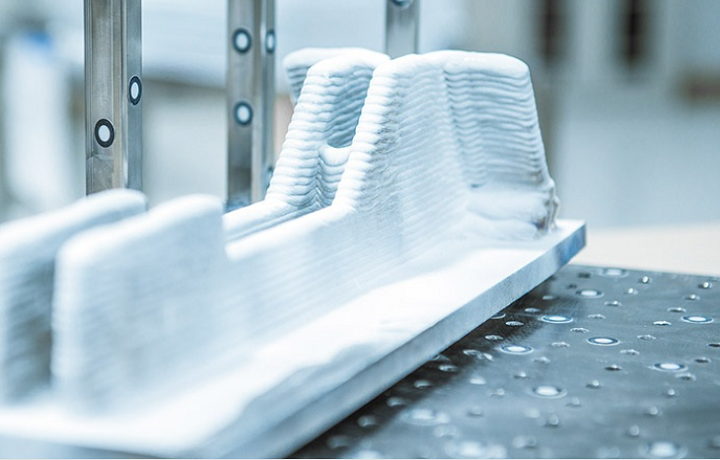Additive manufacturing company Norsk Titanium US Inc. (Norsk) specializes in structural, aerospace-grade titanium components, and was actually the first to have its 3D printed titanium structural components approved by the Federal Aviation Administration to be used in a commercial airplane, the Boeing Dreamliner, back in 2017. Now, the company has announced production deliveries of new 3D printed components for the Boeing 787 Dreamliner to Leonardo’s South Italy-based Grottaglie Plant, which is part of its Aerostructures Division.
These new Boeing parts were made using Norsk’s patented Rapid Plasma Deposition (RPD) AM process, which it publicly unveiled to the world in 2015. The proprietary technology, which I’ve seen called both a plasma arc method and a DED one, uses an environment of inert gas, such as argon, to melt titanium wire. Then, just like other 3D printing technologies, the heated material is built up quickly in subsequent layers to make the final, near-net-shape part. To ensure accuracy, the RPD process is monitored more than 600 times per second for quality assurance purposes.
Norsk has long put a heavy focus on metallurgy. While other metal materials, including nickel alloys, tool steel, and stainless steel, can all work with the RPD platform, the company—a Tier 1 Supplier to Commercial Airframe and Engine OEMs and a popular partner for aerospace companies—most often uses titanium wire, in order to meet the many exacting requirements of the highly regulated aerospace sector.
RPD printing is said to make the process flow simpler, as well as being able to produce stronger, more durable. Additionally, according to the Norsk website, RPD results in “significantly less machining” than is required for conventional, forge-based methods of manufacturing, which can lead to a major improvement of 50-75% in the buy-to-fly ratio…very helpful in on-demand environments like aerospace that produce safety-critical and structural components.
“Reduced machining also leads to less tooling and energy usage, which are significant cost drivers for titanium parts. The end result is reduced production cost for finish titanium parts, ultimately benefiting the customer,” the website continues.
This newly announced delivery is now the company’s third production customer in the commercial aerostructure space. Additionally, it is also representative of the first recurring order from an aerospace company based in the European Union for Norsk.
“We are pleased to be Leonardo’s supplier. This delivery marks a significant increase in the number of additively manufactured parts previously manufactured from titanium plate. It also is an important step towards our mission to provide an alternative to titanium forgings in aerospace applications,” Karl Fossum, director of customer programs for Norsk, said about the delivery.
Norsk used its industrial RPD process to design and 3D print preforms out of Ti-6Al-4V, a common titanium alloy with great corrosion resistance. By using Rapid Plasma Deposition, the company was able to achieve a more than 40% reduction of raw material needs, as well as maintaining the necessary material properties and process control.
(Images: Norsk Titanium)
Subscribe to Our Email Newsletter
Stay up-to-date on all the latest news from the 3D printing industry and receive information and offers from third party vendors.
You May Also Like
Printing Money Episode 17: Recent 3D Printing Deals, with Alex Kingsbury
Printing Money is back with Episode 17! Our host, NewCap Partners‘ Danny Piper, is joined by Alex Kingsbury for this episode, so you can prepare yourself for smart coverage laced...
Insights from Cantor Fitzgerald on AM’s Q1 2024 Landscape
A recent survey by Cantor Fitzgerald sheds light on the persistent challenges within the additive manufacturing (AM) industry in the first quarter of 2024. Based on responses from 38 industry...
3D Printing Financials: Xometry’s Scaling up and Strong Start to 2024
Xometry (Nasdaq: XMTR) kicked off 2024 with strong results, boosting its marketplace and technology to new heights. Both revenue and gross margin soared, fueled by an expanding global network of...
3D Printing Financials: Desktop Metal Targets Recovery Amid Net Losses and Revenue Downturn
Despite facing a decline in revenue and the persistent challenges of a tight economic climate, Desktop Metal (NYSE: DM) is making strides toward operational efficiency. The first quarter of 2024...



































